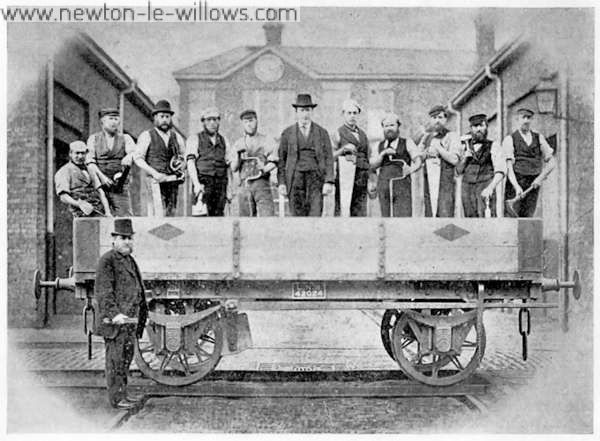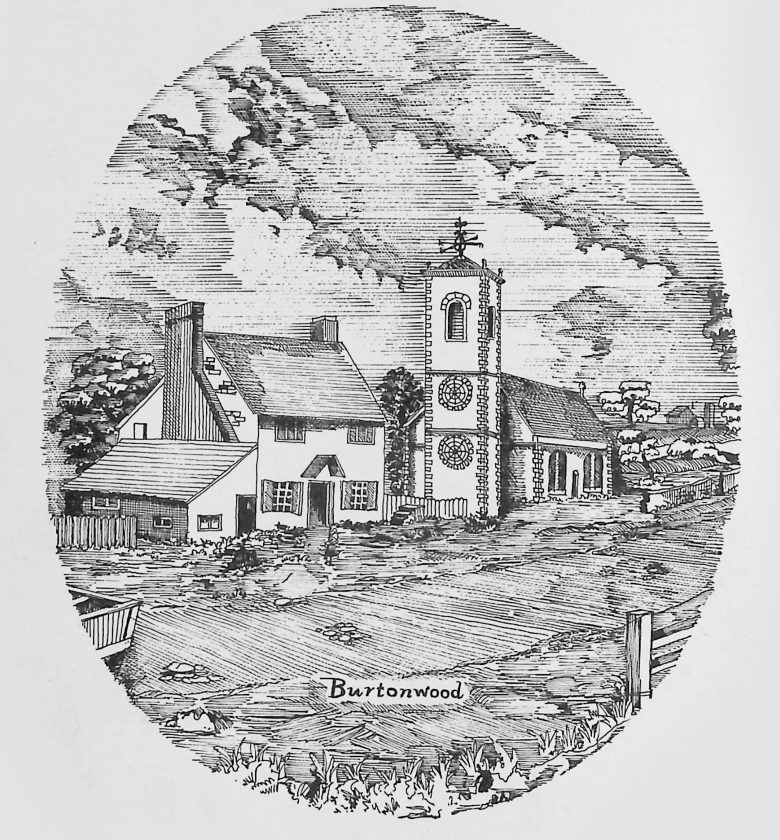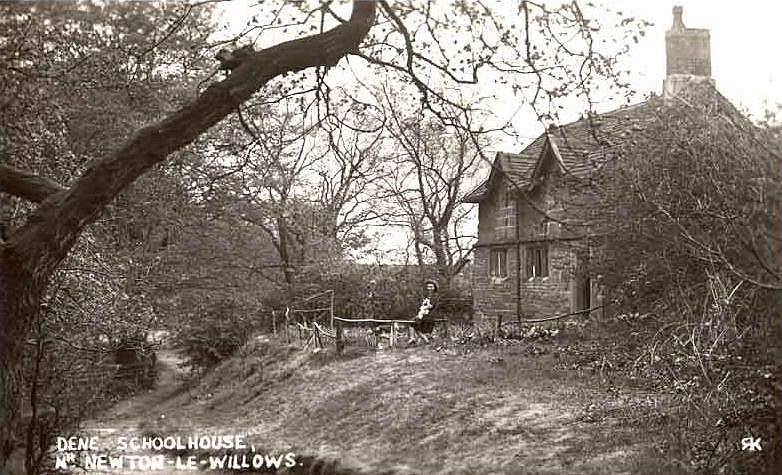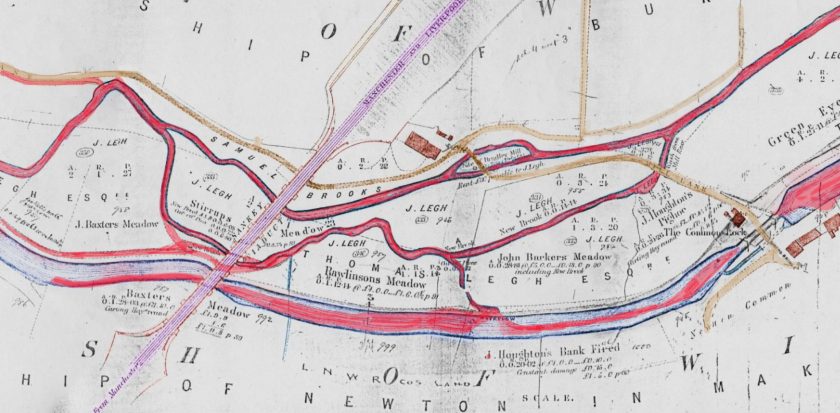One hundred and fifty one years ago, on March 1, 1853, the London & North Western Railway leased from Jones & Potts a small engineering works known as the Viaduct Foundry, so named from its proximity to Stephensons Sankey Viaduct over the St. Helens Canal on the original Liverpool & Manchester Railway. Seven years later, on May 11, 1860, the L.N.W.R. purchased the property outright for the sum of 15,000. The Viaduct Works was founded by Jones, Turner & Evans in 1833, and among other products, including pumping machinery for the nearby mines, a large number of locomotives were built in its early days. It had rail connections at the east end of Sankey Viaduct, and it is asserted locally that the Rocket and other L.M.R. locomotives were serviced in the works ; proof of this claim to fame is lacking, but recent excavations under the floor of one of the original shops have revealed .a line of square stone sleepers with cast-iron rail chairs and chair bolts set in lead, presumably early Liverpool & Manchester permanent way.
By 1853 the owners were Jones & Potts, and the works covered about eight acres and included some 33 workers cottages, all of which were later demolished to make way for the development of the factory under railway management. The country lane giving access to the foundry called Pepper Alley Lane, was later renamed Earle Street as a compliment to Mr. (later Sir) Hardmann Earle, the L.N.W.R. director under whose guidance the company bought and developed the works, and whose name is also perpetuated in the name of the township built by the L.N.W.R. close by the works for the employees, Earlestown.
Towards the end of 1852, the locomotive shops at Crewe had become inadequate for the number of repairs currently required, and it was decided in January, 1853, that the Edge Hill shops, Liverpool, should concentrate wholly on locomotive work, and additional accommodation would have to be found for the operations of the Wagon Department of the Northern Division of the L.N.W.R. Negotiations were entered into with Jones & Potts, who were prepared to lease the foundry for two years at p650 per annum or for seven years at 600 per annum. It was stated that there was accommodation for building 1,000 wagons and 50 engines per annum, and the premises to be let included ” one 24 horse engine, one 18 horse engine, 40 smiths fires, one large hooping furnace, one foundry, three cupolas, one brass foundry, gas apparatus, one office and drawing room, warehouse, dining room for 200 men and stable for eight horses.”
The rapid expansion of the works under L.N.W.R. ownership was begun by Mr. Owen Owens, the first Works Superintendent, and continued from 1867 by Mr. J. W. Emmett, under whom practically three-quarters of the shops in existence today were built, although some of them have been put to several different uses since that time. As soon as Mr. Owen Owens took over the works, the first order for ” 300 wagons to be built with spring buffers on the last improved principle.” was placed. To accommodate the work, a new wagon shed was authorised early in 1854, additional land already having been purchased adjacent to the long smithy, and land was also bought for the erection of cottages for the men employed at Newton Wagon Works, as it was then called.
By 1864, wagon production was in full swing and Mr. Owens reported that the production for that year was 1,171 rail and ten road vehicles on Capita I Account, and 381 rail and one road on Renewal Account. The production of new vehicles varied with the orders placed on the works. It was also engaged on heavy repairs to wagons, and the manufacture of wheels, iron and brass castings and wrought iron parts, not only for the use in the works, but for dispatch to the repair depots and out-stations in the Northern District. At that time they came under the jurisdiction of the Works Superintendent, who was responsible to the Board of Directors, through the Locomotive & Engineering Commit-tee, the meetings of which he attended, at Crewe, Wolverton, and Earlestown in rotation. This system of control continued until the grouping in 1923.
The personnel employed in the works in 1901 was approximately 2,000, and the capacity at this time is reported to have been 4,000 new wagons per annum, 13,000 heavy repairs and 200 to 300 new horse-drawn vehicles of various types for the cartage department, as well as the production of new and repaired details in the forges and foundries for use in the factory, and at the outstations. The steam-driven machinery was beginning to be replaced by electrically-operated machines at this period, and two engines for driving dynamos for shop lighting and the operation of some of the machines such as lathes, drills, punching machines and wagon traversers were already at work.
The period from 1903, when Mr. Emmett retired, to 1923 was not remarkable for great changes, but steady improvement took place in keeping with production requirements, particularly in , the gradual changeover from steam to electric power. A new wagon shop, known as the White Shop, at the extreme east end of the works, the last extensions to the machining and fitting shop, and the brass foundry were added in 1913-14, all in reinforced concrete and steel, which was a departure from tradition as the remainder of the works is built in dull red brick. The provision of the White Shop, equipped with two 20-ton and two 6-ton overhead travelling cranes, enabled the repair of goods brake vans, bogie wagons, and special vehicles to be concentrated there.
The full impact of the grouping of 1923 on the works at Earlestown was not felt until nine years later, when the rationalisation of workshop capacity which, in accordance with L.M.S.R. policy, aimed at concentrating certain work at factories considered best suited, resulted in all manufacture of freight rolling stock being transferred to other factories and the discontinuance of ancillary processes such as the iron and brass foundries, wheel making, stamping and rolling mill. Instead the works became the principal L.M.S.R. factory for heavy repairs to wagons and the manufacture and repair of door-to-door containers of all types. The repair of road vehicles, horse-drawn and motor, was maintained, and the manufacture of wagon laminated springs and three-link couplings for the whole system was concentrated at Earlestown.
In 1925, shortly after the grouping, Mr. (later Sir) Ernest Lemon had become Superintendent of Earlestown He introduced new methods of wagon construction, and standard wooden-frame open goods wagons were produced by mass production on a production-line system. This entailed a much faster use of timber, to facilitate which the inadequate single short run overhead crane in the timber yard, was replaced by two 10-ton over-head cranes which traversed the full length of the stack and greatly speeded up handling. The mass production of new wagons continued for seven years, during which time 19,540 standard wooden-frame wagons were built.
The repairing of wagons continued on the old system during this period, and it was not until both Mr. Lemon and his successor Mr. W. G. Smalley had gone and Mr. W. Anthony took over in 1931, that the repair of wagons on progressive lines was begun. On Mr. Anthony fell the task of reorganising the works so that it could absorb the wagon, lorry and road motor body repairs transferred from Newton Heath, which took the place of the new work lost by Earlestown. The progressive system was applied throughout necessitating the introduction of many power-operated hand tools, both electric and compressed air, and the building of suitable staging to enable the operations to be carried out as expeditiously as possible.
The use of electric power increased greatly, and the internal movement of wagons into the shops was carried out by shunting tractors, which replaced electric capstans. The whole of the works shunting is now done by these tractors except the placing of cripple wagons into the yard at the east end and the removal of repaired wagons in train loads twice daily, and the shunting in the White Shop which is by a steam locomotive. By 1934 the reorganisation was virtually complete, and the breaking up of wagons was also dealt with by progressive methods, in a new timber and steel building, erected at the south-west end. By this time the stamping shop bolt shop, forge, rolling mill and the iron and brass foundries had been abolished, although the names indicative of their one time activities persist to this day.
Progressive methods of manufacture were also applied in the spring shop, where an oil-fired rotary furnace, accommodating eight sets of spring plates, heats the plates already punched, sheared and nibbled. They are then shaped hot under a hydraulic press, hardened, and then tempered in another oil-fired furnace, the whole operation being facilitated by gravity operated rollers. Finally, the buckling operation is carried out under a hydraulic press. The manufacture of one five-plate standard wagon spring under the best conditions occupies approximately five minutes after heating, and the output of this shop is sufficient to meet the wagon spring requirements of the whole system, about 500 a week.
In October, 1943, the old method of manufacturing three-link wagon couplings by hand forging was discontinued and an electric flash-butt welding process was brought into use. The whole of the wagon coupling requirements for the London Midland Region, for new wagons as well as replacements on wagons already in service, are manufactured on this plant, the average weekly output being about 1,000 complete couplings.
The year 1946 saw Mr. Anthonys retirement and the appointment of Mr. A. E. Bates, who made a number of important changes in the shop layouts, so that the large numbers of wagons which were standing idle waiting repair, due to the after effects of war, as well as the increasing number of steel-frame and all-steel wagons, could be dealt with more expeditiously. The result was that the overall output was raised from an average of 224 per week to 310, and the concentration of repairs to timber-frame wagons at the west, or new works, end of the works, and the steel-frame and all-steel wagons at the east end.
Two other activities new to the works were the weaving of standard lubricating pads by female labour, whose output now averages 2,000 per week, and the erection of a firelighter factory, where a battery of machines convert waste timber, sawn and chopped to size, and shavings into firelighters, which are dipped into a hot naphthalene bath and allowed to cool. These firelighters are used at motive power depots for lighting engine boiler fires and production commenced in June, 1946, and is now approximately 650 gross a week.
Mr. Bates was succeeded by Mr. E. Stanley, who, in 1948, became the first Superintendent at Earlestown under nationalisation. The wagon availability situation, due to the large number of vehicles awaiting repair, was still very serious, aggravated by certain shortages of materials, so that considerable ingenuity was required, not only to keep up the output of wagons, but to increase it, and many expedients were adopted to achieve this end, such as by greatly increasing the use of electric welding in the fabrication of metal parts. In 1949 and 1950 large numbers of British-designed all-steel mineral wagons which had been built for use on French Railways, after the liberation, were bought by the Railway Executive to assist the mineral wagon situation, but before they could be used modifications were necessary to suit British Railways and large numbers were dealt with at Earlestown.
Two other developments were the introduction of a progressive repair layout for Scammell trailers, used in connection with three-wheel mechanical horses, and the reintroduction into Earlestown Works of the building of new rolling stock, of the non-passenger carrying coaching stock type, beginning with 30 motor-car vans which were built in the White Shop. This new trend, of considerable importance to Earlestown, as it provides a greater variety of work for the staff and encourages new trades, has continued under the present Works Manager, Mr. H. E. Kemp; 25 cattle vans were built in 1952, and an order for 100 horse boxes of ex-L.N.E.R. design has been placed on Earlestown for building in 1953 and 1954 at the rate of two per week. The construction of new containers of all types is also increasing and a record order for 1954 has already been placed on the works, comprising 2,510 in all.
Other major activities which have been authorised, and are already in their initial stage are the provision of a new layout for the repair of all-steel wagons which will displace the existing steel-frame layout, and the extension of the testing plant for vacuum brake details. An apprentices training school, similar in general principles to those already operating at Derby Locomotive Works and Derby Carriage & Wagon Works and authorised for Wolverton and Crewe, has been authorised for Earlestown, and work on it will commence shortly.
The output of the works principal activities in 1952 was as follow :
| Open stock repaired | 12,675 |
| Covered stock repaired | 5,385 |
| Wagons broken up | 2,717 |
| Containers repaired | 1,456 |
| Containers broken up | 417 |
| Containers built | 1,658 |
| French wagons converted | 250 |
| Lorries and flats repaired | 20 |
| Scammell trailers repaired | 675 |
| Lorries broken up | 26 |
| Prize cattle vans built | 25 |
| Springs manufactured | 13,107 |
| Springs repaired | 44,400 |
| Three-link couplings manufactured | 57,000 |
| Lubricating pads manufactured | 107,699 |
| Firelighters manufactured | 26,280 |
| gross Demountable beer tank chassis manufactured | 7 |
| Silicate of soda chassis manufactured | 6 |
Since 1853, the area covered by Earlestown Works has been increased from 8 to 36 acres, of which 14i is covered shop area, and about 1,900 persons are employed there. At the centenary celebrations held at Earles-town on May 16, a passage from an article on the works in the December, 1901, issue of The Railway Magazine was read. This quoted the establishment of the Earlestown Institute as an example of the mindfulness of the directors of the L.N.W.R. for the material and moral welfare of their servants. The building, known as the Viaduct Institute, was opened late in 1877. With its six acres of grounds it is now the centre of extensive sporting and other recreational activities for the works employees.
From an article in the August 1953 edition of The Railway magazine, the magazine doesnt say who the original author of the text was. this version is transcribed and edited by Steven Dowd ©2004



